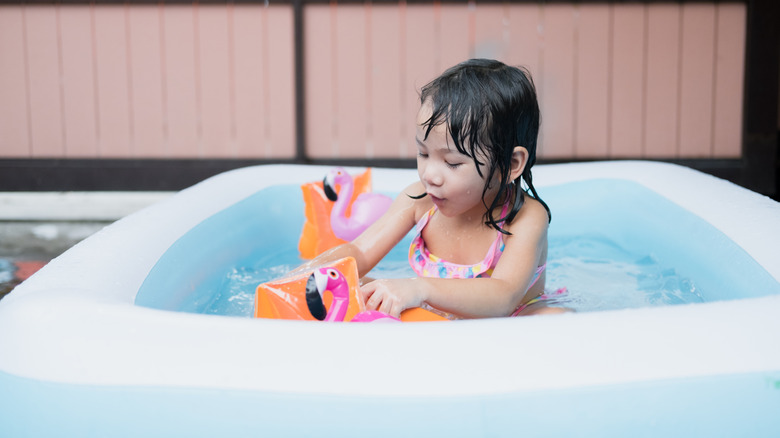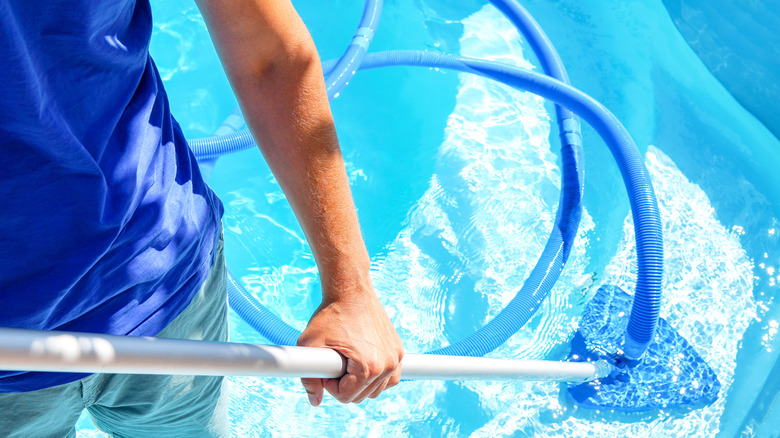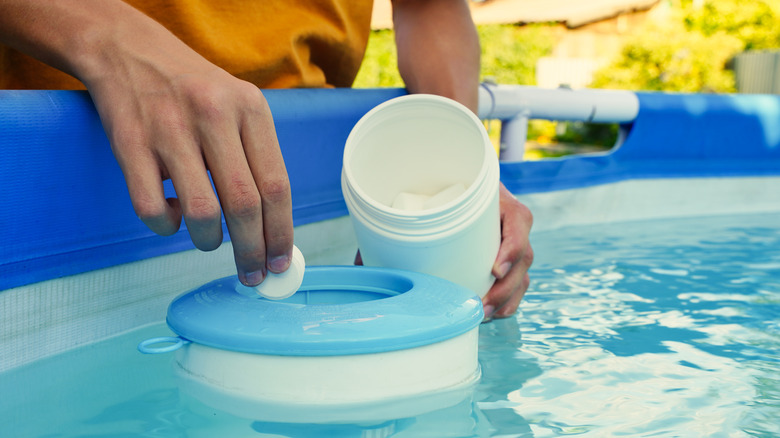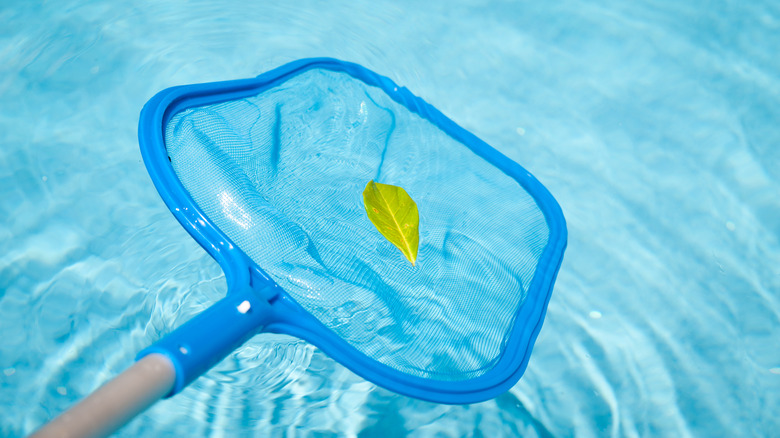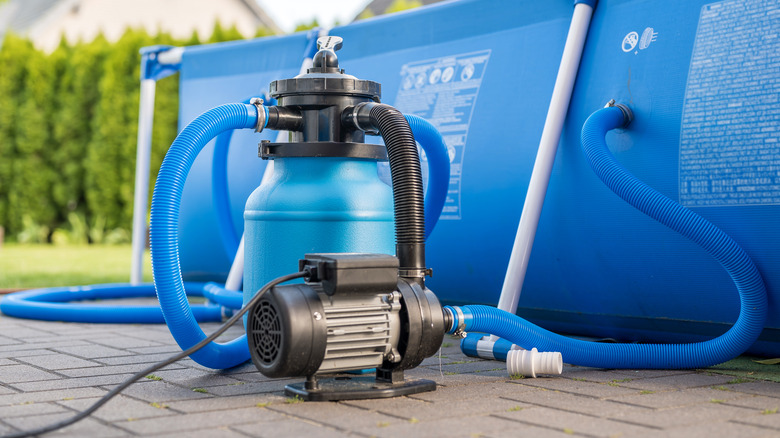5 Tips To Keep Your Kiddie Pool Clean All Summer Long
If you have kids, you know how much they love to splash around in a kiddie pool. However, draining the pool afterward can be a lot of work. So, you may leave it full of water for a few days at a time instead of emptying it right away. After all, the kiddos are bound to jump back in many times during the warm summer season. However, kiddie pools can accumulate a lot of debris since children are running in and out of the pool. From grass to bugs and dirt, plenty of things can land in an inflatable kiddie pool.
Maintaining your pool clean is essential to thwarting bacteria growth that could make your children sick and prolonging the longevity of your kiddie pool, via Pristine Pools. Fortunately, there are many ways you can keep your kiddie pool clean all summer long. Take a look at the following tips to ensure your kids' pool is safe and clean to swim in.
1. Purchase a pool vacuum
A pool vacuum allows you to quickly and effectively clean your kiddie pool, plus it's easy to use. There are two types of pool vacuums: manual and automatic, per Home Depot. As the name implies, manual pool vacuums require you to manually move the cleaning device around your pool to catch dirt and debris. On the other hand, automatic pool vacuums will travel around the floor of your inflatable pool to pick up litter, similar to a household robotic vacuum or mop.
There are several manual and automatic pool vacuum models, ranging in prices and features. The best one for you ultimately depends on your budget and specific needs. We recommend purchasing a pool vacuum that's specifically designed to clean small, above-ground pools. To use a manual small pool vacuum, lower the chosen device into the pool and move it like a standard indoor vacuum. Make sure that the head of the vacuum remains in contact with the floor of the kiddie pool for maximum cleanliness.
2. Don't use chlorine, bleach, or other disinfectants
The U.S. Centers for Disease Control (CDC) advises against using pool disinfectants in kiddie pools, such as bleach, chlorine, or bromine. This is because it's hard to determine how much solution your inflatable or plastic pool needs to keep it sanitary. As a result, you may add too much disinfectant, which can harm one's health. You may also add too little, leading to the pool water not being clean at all.
So, what can you use instead to fix a green pool and ensure the water is hygienic for prolonged use? Natural cleaners, such as white vinegar, salt, or baking soda, can be a great option. However, many experts, such as In the Swim and The Maids, still suggest that chlorine remains the best way to maintain pool water sanitary — despite the CDC's recommendations. If you're planning on using chlorine tablets to treat your kiddie pool's water, follow the packaging instructions closely and test the water before and after each use.
3. Use a pool rake to remove debris daily
Pool rakes are handy tools enabling you to remove debris from your kiddie pool, including leaves, grass, and bugs. Not only can waste make the water look unappealing, but it can also reduce your kiddie pool's lifespan. As explained by Pools by Ricketts, debris can cause plastic kiddie pools to tear and increase the likelihood of algae growth. Excessive amounts of litter can also impact a child's health, resulting in irritated or infected skin, eyes, and ears. Plus, you wouldn't want to swim in a pool full of sticks and dirt.
This essential pool cleaning tool features a long pole handle that's attached to a net, like a bug catcher. So, you can scoop up any debris with ease. Pool rakes are also a more affordable option when compared to water filters, pool vacuums, and other costly pool-cleaning tools. The best part is that pool rakes can even double as toy catchers.
4. Invest in a pool filter
A small pool filter can make pool maintenance a breeze. Pool filters remove debris, including dirt, bugs, leaves, and bacteria, to ensure clean and safe water for hours of summer fun. However, most kiddie pools don't come equipped with this type of device, so you'll have to purchase one yourself. According to Nasaswim, the best kind of pool filter for kiddie pools are cartridge filters because they're smaller than Diatomaceous earth and sand filters. Additionally, cartridge filters are easy to maintain, don't require daily cleaning, and are energy efficient, so you don't have to worry about your electricity bill skyrocketing due to frequent use.
Despite their great perks, cartridge filters are slightly more expensive than the alternatives, ranging from $101 to $900. Another drawback is that you'll have to deep clean the filter once or twice annually, which may only last a few years, via Swim University.
5. Cover your kiddie pool when not in use
Many people often wonder if they should cover their kiddie pool if they're not going to use it. But one of the best ways to keep your kiddie pool clean and minimize your pool expenses is to cover it when not in use. This is because pool covers keep debris out of the pool, allowing you to enjoy fresh, clean water the next time you use it and increase the lifespan of the plastic or inflatable pool. Using a pool cover also minimizes how much water evaporates, reducing your water consumption and lowering your water bill, per the U.S. Department of Energy. How much you spend on a pool cover depends on size and quality.
To use a pool cover to its full potential, put the cover back on as soon as your children are done playing in the water. If you notice any signs of tearing, make sure to mend holes promptly or replace the cover completely.
